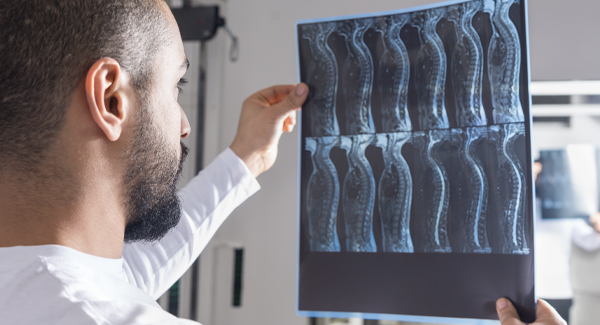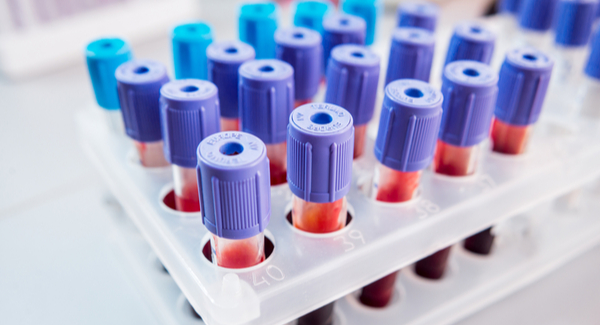Testing for Axial Spondyloarthritis
Lab and imaging tests are used to diagnose axSpA and find out if treatments are working.
By Mary Anne Dunkin | June 13, 2022
Diagnosing axial spondyloarthritis (axSpA), including ankylosing spondylitis (AS) and nonradiographic axial spondyloarthritis (nr-axSpA), can be challenging and take time. There is no single test to diagnose it. Rather, the diagnosis is made based on symptoms, a physical exam, the findings of lab and imaging tests, and your doctor’s judgment.
Blood Tests
Most of the following tests are done to find signs of inflammation in the body. However, not all people who have axSpA will have a positive result, and even if inflammation is detected, it could indicate a number of different inflammatory conditions, including other types of arthritis. Other considerations go into diagnosing axSpA, including the presence of HLA-B27.
- Erythrocyte sedimentation rate (ESR or sed rate). The ESR can gauge how much inflammation is in your body by measuring how quickly red blood cells (erythrocytes) separate from other cells in the blood and collect as sediment in the bottom of a test tube.
- C-Reactive Protein (CRP). The CRP test measures levels of CRP, a protein produced by the liver that signals inflammation. High CRP levels are common in axSpA and other inflammatory forms of arthritis.
- Plasma Viscosity (PV). This test measures the blood’s viscosity, which is affected by proteins produced in response to inflammation. A positive result could mean axSpA or other inflammatory form of arthritis.
- HLA-B27 test. This blood test is not for inflammation; instead, it identifies human leukocyte antigens (HLAs), molecules on the surfaces of the body’s cells that play an important role in the immune response. HLA-B27 is a specific HLA associated with axSpA and related diseases. While not all people with axSpA test positive for HLA-B27, approximately 90% do, making it an important diagnostic tool for someone with axSpA symptoms.
Imaging Tests
- X-ray. X-rays of the spine and pelvis showing characteristic bone damage can be useful in diagnosing radiographic axSpA, known as ankylosing spondylitis. In non-radiographic axSpA, however, X-rays don’t show damage despite symptoms, making the diagnosis more difficult.
- Ultrasound. Ultrasound, or sonography, which uses sound waves to create pictures of structures inside the body, may be useful in diagnosing axSpA by showing characteristic inflammation where the tendons and ligaments insert into the bone.
- Magnetic resonance imaging (MRI). In this procedure, radio waves and a powerful magnet linked to a computer are used to create 3D images of structures inside the body. Because MRI can detect inflammation in the joints and small erosions related to inflammation, it may be useful in diagnosing axSpA when changes are not seen on X-ray, known as nr-axSpA.
- Computed Tomography (CT) Scan. A CT scan is an imaging procedure that combines a series of X-ray images to create cross-sectional images of parts of the body. CT scans can be effective for viewing sacroiliitis, inflammation of the joint where the lower spine and pelvis connect, a sign of axSpA. However, because of the radiation exposure that occurs with CT, your doctor may first choose other imaging options.
Monitoring AxSpA
Regular follow-ups with your doctor as well as your own assessment of your symptoms and functioning are important indicators of axSpA progression, disease activity and/or response to treatment. Your doctor may have you complete one or more surveys to gauge your pain and fatigue levels, spinal stiffness, level of difficulty doing daily activities and other factors. In conjunction with these, your doctor may order some of the same tests used to diagnose axSpA to monitor inflammation over the course of the disease, including
- Erythrocyte sedimentation rate (ESR or sed rate)
- C-Reactive Protein (CRP)
- Plasma Viscosity (PV)
Similarly, your doctor may use imaging tests to monitor for damage caused by the disease or to find evolving clues that might confirm the axSpA diagnosis. These tests, which include the following, may be the same tests used to make your diagnosis.
- X-ray
- Ultrasound
- Magnetic resonance imaging (MRI)
- Computed Tomography (CT)

Stay in the Know. Live in the Yes.
Get involved with the arthritis community. Tell us a little about yourself and, based on your interests, you’ll receive emails packed with the latest information and resources to live your best life and connect with others.



